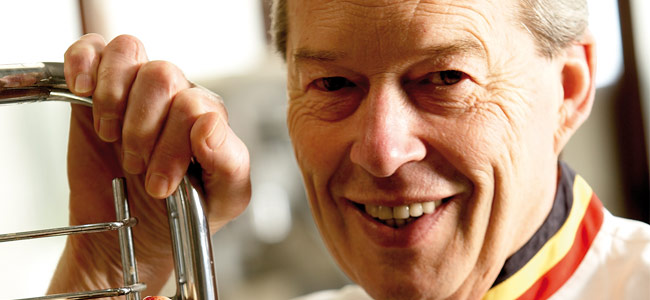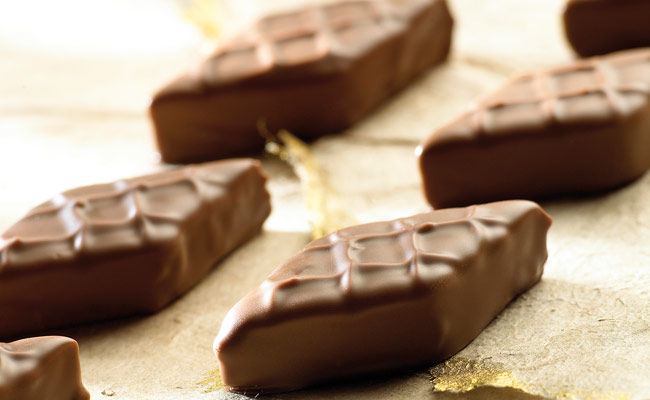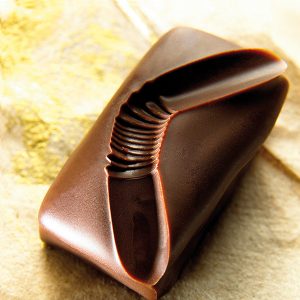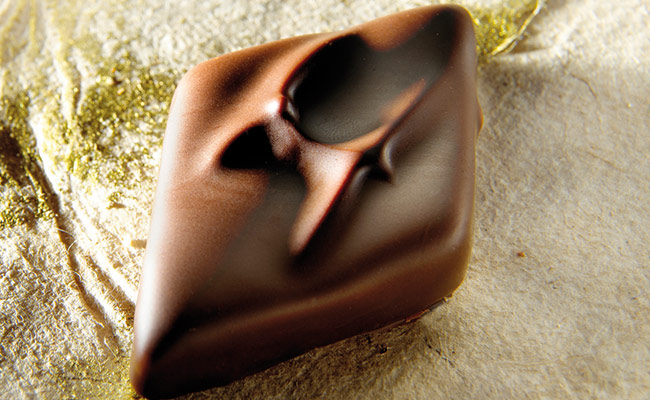Categories Pastry Chef Articles
Jean-Pierre Wybauw in memoriam. A Fine Chocolatier, A Great Teacher

The Belgian chef Jean-Pierre Wybauw -Mr. Chocolate- died on Tuesday, June 19 due to ALS. Known as Mr. Chocolate, he turned his hobby, chocolate, into his life and his business, traveling all over the world to teach the secrets of the trade.
Jean-Pierre Wybauw did not always want to be a chocolatier. Growing up in Belgium in the 1940s, he and his brothers and sisters were well acquainted with the demanding life of a chef. Their parents owned and operated a restaurant, and although successful, the demands of their parents were keenly felt by the young Wybauws, who rarely even had the opportunity to sit together at the dinner table. As a youngster, Wybauw dreamed of leaving home and becoming a doctor, not realizing at the time, he said, that he and his sisters were in the presence of a “gold mine.” His parents’ thriving restaurant had earned one Michelin star, an honor distinguishing its excellence, but no one in the family wanted to take over the business.

Here is an article published in so good #5 where Lindsay Koriath, of The French Pastry School, reviews his successful career.
When Wybauw was 17, his father decided to send him to culinary school in Brussels. He was not initially happy with the decision but was eventually able to find a subject he could willingly pursue. He knew what he did not want to study – cooking, serving, nor learning to become a butcher. “So what’s left was bakery, pastry, sugar and chocolate. The last two sounded very good.” He enrolled in the four-year program studying all four subjects, focusing on chocolate and sugar arts during the latter two years. He continued his studies at the same school to earn teaching certification and began teaching several years later.
Wybauw’s training also included experimentation and self-education; however “with self-education, you need to have enormous discipline. You need to say to yourself, I must spend, for example, one hour every day on self-study. If you can do that for a couple years, you will be thankful that you had the courage to do that.” Wybauw certainly learned a great deal from the pastry chefs and chocolatiers he mentored with as well, and advises his own students to learn in the same way. “Work with good professionals, but stay not too long. Stay there one year until you have seen everything,” Wybauw advises. “I know many don’t like to hear this, but this is reality. You need to work with different methods. It can be hard because sometimes you work one year in a pastry shop and you make friends, and you need to decide to stop and go to another one and start over again. That is hard, but it’s the best way to learn.”
“Work with good professionals, but stay not too long. Stay there one year until you have seen everything”
During the four years after graduating from culinary school and before he began teaching, Wybauw worked at prestigious pastry and chocolate shops in Belgium such as L. Willems in Antwerp, the biggest pastry shop in the city. From there, he went on to Del Rey, another high quality pastry boutique in Antwerp. Later, Wybauw bought his own shop with his wife whom he had met at L. Willems. “I married the first girl I met. We worked together in pastry. [Nelly] was selling in the front of the shop, and I was in the basement working in pastry. To have money, we took over a pastry shop.” They bought a store in Antwerp from a proprietor who had been buying the items he sold from another producer. “We wanted to change that. My intention was to raise the production of [chocolate] bonbons.”
The Wybauws’ plan worked, and their chocolate shop did very well. It was conveniently situated near a film factory which employed about 11,000 people. “When a shift stopped or started, they were standing in line at the shop.” It was during his time as proprietor of his pastry and chocolate shop that he performed an experiment which lead to a development revolutionizing chocolate decoration for the industry world-wide. For the last Easter holiday of the shop’s existence in 1965, Wybauw made a large chocolate egg. “I had to make a huge mold myself, and it was so big that we could not fit it through the front door of the shop. So we had to cut it in two, and glue it again inside the shop.
“Then I wanted to make a nice painting on top, but I took some risk painting directly on the egg with cocoa butter and cocoa powder. I said, there must be a solution in a way that I have no risk.” Wybauw created a large drawing, attached some clear cellophane over his drawing, painted on top of that with cocoa butter, and then affixed the cocoa butter painting. He let this set, removed the cellophane, and his print remained on his egg. “So, I had the first transfer sheet.” His painted egg was a hit and appeared in the newspaper the next day. “We sold out completely!” Transfer sheets, today made of acetate and used not just in chocolate sculpture making, but also candy making, have become a staple of chocolatiers around the world. “I’m happy, proud that I started with this system,” said Wybauw.
“Transfer sheets, today made of acetate and used not just in chocolate sculpture making, but also candy making, have become a staple of chocolatiers around the world”
 Although a success, Mr. and Mrs. Wybauw’s shop lasted just a couple years. “You never know in advance how your life is going to go,” says Wybauw, “and if it was the best choice, starting my own business or going into education.” He received an offer from the culinary school in Anderlecht (near Brussels) to teach chocolate and sugar work. He was an instructor there for seven years. During his tenure as an instructor, he fulfilled a special order for a caterer. He was asked to make another chocolate egg – even bigger than his famous painted Easter egg – one large enough for a girl to sit inside and “be transported on an open truck through the streets of Leuven, Belgium. Okay, I made that.” Wybauw had to construct a round table with a hole in the center to hold the egg while being transported. The top of the egg was pre-cut for the girl to climb inside. He drilled a couple holes in the egg so she could see and know when to make her grand exit. A thin layer of chocolate was coated over the cut portion so that it appeared to be a solid egg. After completing the trek through Leuven, “the girl had to come out of the egg and offer a box of chocolates to the mayor.” The grand event was filmed on television and helped propel Wybauw toward becoming an important figure in the chocolate world.
Although a success, Mr. and Mrs. Wybauw’s shop lasted just a couple years. “You never know in advance how your life is going to go,” says Wybauw, “and if it was the best choice, starting my own business or going into education.” He received an offer from the culinary school in Anderlecht (near Brussels) to teach chocolate and sugar work. He was an instructor there for seven years. During his tenure as an instructor, he fulfilled a special order for a caterer. He was asked to make another chocolate egg – even bigger than his famous painted Easter egg – one large enough for a girl to sit inside and “be transported on an open truck through the streets of Leuven, Belgium. Okay, I made that.” Wybauw had to construct a round table with a hole in the center to hold the egg while being transported. The top of the egg was pre-cut for the girl to climb inside. He drilled a couple holes in the egg so she could see and know when to make her grand exit. A thin layer of chocolate was coated over the cut portion so that it appeared to be a solid egg. After completing the trek through Leuven, “the girl had to come out of the egg and offer a box of chocolates to the mayor.” The grand event was filmed on television and helped propel Wybauw toward becoming an important figure in the chocolate world.
In 1972, he received another interesting offer from a chocolate company that started as a small family business and is now the world’s leading producer of chocolate. Wybauw accepted a position with the company as a technical advisor and instructor. Now an independent consultant, Wybauw has traveled to many different countries to teach. He strives to show his students as many techniques and methods as possible. It’s important to Wybauw that his students understand why and how ingredients work together. “I’m maybe different from other teachers. The easiest way is to give them a lot of recipes, but I don’t like this system. Recipes you can find in all kinds of books, on the internet – thousands of recipes – but explaining how and why, what is the function of the ingredient, what is advantageous and what is disadvantageous? So that they can decide themselves what is a smart idea. That is important and has always been my way of working.”
“I’m maybe different from other teachers. The easiest way is to give them a lot of recipes, but I don’t like this system. Recipes you can find in all kinds of books, on the internet – thousands of recipes – but explaining how and why, what is the function of the ingredient, what is advantageous and what is disadvantageous? So that they can decide themselves what is a smart idea
Wybauw found an additional means to sharing his expertise beyond the classroom and teaching kitchens. He began writing articles early in his career, even creating comics for a pastry magazine, and in 2004 published his first book. His intention was to write an informative book for professionals and chocolate enthusiasts in hopes that it would answer many of their technical questions. Wybauw has received hundreds of different inquiries over the years: “’Sir, why is my chocolate blooming?’ or ‘Why is my chocolate thickening but has the right temperature?’ often the same questions. I said, it’s high time to educate and explain in clear ways, what are the reasons.”
Wybauw felt the success with his first book came with the presentation of clear, scientific explanations. Fine Chocolates: Great Experience, Vol. 1 was the first of several books by Jean-Pierre Wybauw that earned wide acclaim and prestigious awards, including Gourmand’s “Golden Ladle” award. Wybauw never anticipated such a success with his first book which has been translated into nine languages. His second book, Chocolate without Borders was written with the idea in mind to donate the book’s earnings to Doctors without Borders/Médecins sans Frontières. Wybauw explains that he has seen many great things in his world-wide travels, “but also things that hurt you. I am very sensitive to that,” that is, to the countless people he has encountered less fortunate than he. “I wanted to do something. This is my part, and I’m happy for that.” Wybauw’s third book, Decoration Techniques was followed by Fine Chocolates: Great Experience, Vol. 2, focusing on ganache fillings. His fifth book, Fine Chocolates: Great Experience, Vol. 3, Extending Shelf-Life became available in September, 2010.

The ever-changing industry is still exciting to Wybauw, and the evolving palate of the modern consumer poses interesting and new challenges. “For example, sugars that even ten years ago nobody heard about” are now available, and not just to the major companies but also to individual consumers. People want their desserts “less and less sweet. Big problem for extending shelf life.” Working with different combinations of sugars and finding solutions is a fascinating challenge to Wybauw.
“When you can do your hobby as your business, then you can live happily. That gives me energy, makes me feel young even though I am 67, I’m still dynamic”
All the facets of his career in chocolate motivate Jean-Pierre Wybauw to continue. “That is my life; that is my hobby. When you can do your hobby as your business, then you can live happily. That gives me energy, makes me feel young even though I am 67, I’m still dynamic.” What gives Wybauw the greatest joy is passing his knowledge on to others. He receives many emails from former and future students asking when he will return to the United States to teach. “So I always advise this school, The French Pastry School.” Wybauw begins to tear up a little as he says, “I know that some come especially for me, and I love that.”
Jean-Pierre Wybauw taught Continuing Education classes at The French Pastry School for the past six years, from 2004 to 2010.


